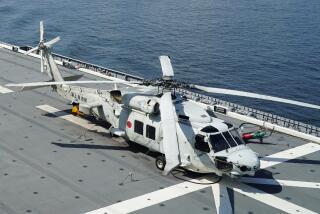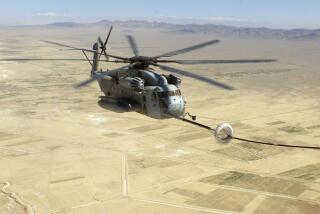Navy Crash Wreckage Found on Ocean Floor
After four weeks of scouring the ocean floor, sailors aboard a miniature submarine found wreckage from the mid-air collision between two P-3 Orion planes that killed all 27 crewmen this spring, Navy officials said Thursday.
The discovery could help officials piece together what led to the March 21 crash--one of the worst in recent military history.
âObviously, the flight recorder or that type of equipment could provide a clue,â said Lt. Susan Haeg, a spokeswoman for the submarine base at Point Loma. âWeâve been looking for significant pieces of wreckage.â
Three sailors aboard the tiny submarine, or deep submergence rescue vehicle, called Mystic have combed the ocean floor off Baja California on and off since May 4.
The high-tech submersible, manned by a crew of three, is usually used to rescue crews off disabled submarines. Equipped with sonar and optical recording devices, the Mystic has been searching an area 60 miles southwest of San Diego where the planes were spotted as they collided in a ball of fire.
On Wednesday, the Mystic spotted wreckage from the two planes. The Mystic shipped out again Thursday for another search of the area as officials hoped to find still more debris.
Navy spokeswoman Cmdr. Sheila Graham cautioned that officials still needed to confirm that the wreckage was indeed from the two Orions. Other Navy officials, however, said that officers were all but certain that they had spotted significant debris from the accident.
Although a search was launched immediately after the crash, it was called off after two days and little was retrieved. No bodies were recovered, nor were any major chunks of wreckage found at that time.
Tapes of radar signals indicated that one plane flying at about 2,500 feet climbed into the other plane, flying at about 3,500 feet, which was coming to relieve it. Officials believe pilot error was involved in the accident, which occurred during a routine anti-submarine training mission.
The two aircraft were assigned to Patrol Squadron 50 at Moffett Naval Air Station in Mountain View, Calif. One plane had been flying 7 1/2 hours before the 2:26 a.m. crash.
Navy officials have not yet determined why one pilot abruptly veered up--smashing into the belly of the other plane.
During the early search efforts, the flight recorders were not recovered. But, because the recorder in a P-3 Orion is not waterproof, fire-resistant or designed to endure a crash, officials are not sure how much information could be gleaned from it. It is not yet known whether the recorder is among the newly found wreckage, said Graham, a spokeswoman for the Pacific Fleetâs Naval Air force.
None of the wreckage from the two planes has been moved from the ocean floor, she said. Sailors aboard the Mystic videotaped the wreckage and those tapes will be reviewed by officials with the accident investigation board, or Navy court of inquiry. That board, headed by Rear Adm. B.B. Bremmer, will decide whether to retrieve the wreckage.
Bremmer has delayed issuing a report on the accident until the underwater sweep of the ocean is complete, Graham said.
It is not yet known whether the sailors spotted any remains of the crewâs bodies, Graham said.
The Mystic, which a ship lowers into the water by crane, followed the efforts of the Navyâs unmanned vehicle detachments, or sonar probes dragged by cable attached to a ship.
More to Read
Sign up for Essential California
The most important California stories and recommendations in your inbox every morning.
You may occasionally receive promotional content from the Los Angeles Times.










